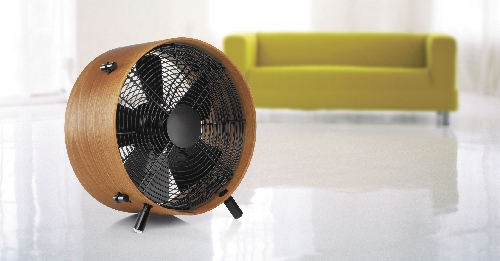Be cool

Fans are cool. Really cool. OK, they help you stay cool.
In the Las Vegas Valley, where temperatures routinely stay in the triple digits during summer, fans — particularly ceiling fans — are almost a necessity.
“The idea behind a ceiling fan is that you can reduce the cost of using your air conditioning by raising the setting on your thermostat,” said Mike Bement, owner of Fanco, which has three locations in the valley. “In my own home I’ve moved the thermostat up 6 to 8 degrees.”
According to NV Energy, ceiling fans offer a low-cost alternative to air conditioning in mild weather and they use about the same amount of energy as a light bulb, which costs just pennies a day to operate.
If you use air conditioning, a ceiling fan will allow you to raise the thermostat setting about 4 F with no reduction in comfort. Or, during moderately hot weather, ceiling fans may allow you to avoid using your air conditioner altogether.
The utility says you save about 1 percent for each degree you change your thermostat.
“Using ceiling fans allows you to run your air conditioner less frequently,” said Nathan Frampton, president of Fanimation. “If you aren’t using your ceiling fan during these hot summer nights, you are costing yourself mega-bucks.”
“The best way to understand the benefits is to do a few simple calculations,” explains Joe Rey-Barreau, education consultant for the American Lighting Association and an associate professor at the University of Kentucky’s School of Interior Design. “If the ambient air temperature is 78 degrees (Fahrenheit), your body will feel as if it is 72 degrees if you are seated under a ceiling fan operating at a low speed. The fan makes you feel cooler by flowing air over your skin, which causes your perspiration to evaporate faster.”
Zeynep T. McLeane of Emerson Air Comfort Products agrees.
“A ceiling fan can make a person feel as if the room is 10 degrees cooler,” he said. “It runs on a fairly low amount of energy that is equivalent to a 100-watt bulb – and even less if it is an Energy Star-qualified fan.”
Bement said the size and number of fan blades isn’t as important as the pitch or angle of the blades and the size and type of motor.
Although any fan will allow you to raise the temperature on your thermostat, Bement said today’s most energy-efficient models run on brushless motors. A typical fan needs 91 watts to operate while a brushless motor needs only about 22 watts.
A brushless motor with six speeds and 60-inch blades will use only 4 watts of energy on the lowest speed to move 2,700 cubic feet of air, Bement said.
Still there are some basic guidelines that people should consider when determining what fan to install in each room.
“Rooms that are approximately 150 square feet or larger require a 52-inch diameter fan to be most effective,” Rey-Barreau said. “Smaller rooms can use either a 42- or a 48-inch diameter model.”
Larger great rooms may require bigger fans with as much as a 72-inch span.
“The majority of ceiling fans sold have five blades, but this is more of an aesthetic consideration rather than a practical one,” he said. “A fan with fewer blades actually moves more air. That’s why if you look at fans located high in a space such as a warehouse, they will typically be industrial-grade, three-blade fans. However, unless a home has extremely high ceilings and the objective is to move a significant amount of air, it is generally acceptable to buy a fan with four or five blades.”
Cliff Crimmings of Craftmade said it’s also important to make sure you get a reversible model.
“In the winter, you want to mix the air in the room without creating any chill factor. The best way to do this is to reverse the fan and run it on low only,” he said.
As to where is the best room to put a ceiling fan in, Bement says it’s any room you spend time in.
That even includes the bathroom, said McLeane.
“There really isn’t an area in the house where people are not installing ceiling fans,” he said. “Bathrooms, garages and closets are also good applications.”
“Here in Vegas, it seems that people put them throughout the house,” Bement agreed.
But if it’s not possible to install a ceiling fan, there are alternatives. The new Otto fan by Swizz, for example, sits on the floor but has the look of a piece of furniture.
It has a wood ring frame made of quartered sapele, which has been oiled twice for a high-quality, matte finish. With three fan speeds and height-adjustable feet, it is versatile enough for any space.
And, just like a ceiling fan, it helps lower the room’s temperature and runs more efficiently than an air conditioner. The Otto uses 45 watts at its highest speed.